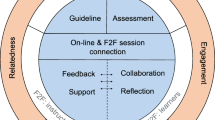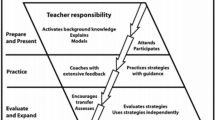Abstract
Though flipped learning has positively impacted teaching English writing, its usefulness in developing students’ English writing performance, autonomy, and motivation is still unclear. This study aimed at investigating the effects of using flipped learning on students’ English writing performance, autonomy, and motivation in learning English writing. It also addressed the factors available in the flipped learning English writing environment that contribute to this effect. Fifteen male and female third-year students in the English department, University of Anbar-Iraq were purposively selected to participate in writing three writing tasks. A qualitative case study research design was used where triangulation of pre-and post-study writing tasks, post-study interview, diaries, and observation was implemented. Data were analyzed qualitatively using content and thematic analysis. Findings indicated that this learning environment has an impact on promoting students’ English writing performance, autonomy, and motivation. Besides, findings revealed that the interactive nature of the learning environment, time and place flexibility, teacher and peers’ feedback, and many learning sources were the main factors that help students improve their English writing performance, autonomy, and motivation. The study concluded that flipping the English writing classes created a user-friendly collaborative learning environment due to the much language and writing knowledge gained. As a result, students’ English writing performance, autonomy, and motivation were enhanced as learners became able to practice writing comfortably.



Similar content being viewed by others
References
Abdullah, M. Y., Hussin, S., & Ismail, K. (2019a). Implementation of the flipped classroom model and its effectiveness on English speaking performance. International Journal of Emerging Technologies in Learning (iJET), 14(09), 130–147.
Abdullah, M. Y., Hussin, S., & Ismail, K. (2019b). Investigating the effects of the flipped classroom model on Omani EFL learners’ motivation level in English speaking performance. Education and Information Technologies, 24(5), 2975–2995.
Abdullah, M. Y., Hussin, S., Hammad, Z. M., & Ismail, K. (2020). Exploring the effects of flipped classroom model implementation on EFL learners’ self-confidence in English speaking performance. In Recent Advances in Intelligent Systems and Smart Applications (pp. 223–241). Cham: Springer.
Adas, D., & Bakir, A. (2013). Writing difficulties and new solutions: Blended learning as an approach to improve writing abilities. International Journal of Humanities and Social Science, 3(9), 254–266.
Ahmed, M. A. E. A. S. (2016). The effect of a flipping classroom on writing skill in English as a foreign language and students’ attitude towards flipping. US-China Foreign Language, 14(2), 98–114.
Al-Bahrani, R. H. (2020). Flipped classroom as a new promoting class management technique. Journal of College of Education/Wasit, 2(39), 591–610.
Alkhoudary, Y. A. (2019). Flipping the classroom towards learner autonomy in an EFL writing class. In Proceedings of the 1st applied linguistics and language teaching conference: Teaching and learning in a globalized world (pp. 47–36). Dubai: Zayed University press.
Alm-Lequeux, A. (2006). CALL for autonomy, competence and relatedness: Motivating language learning environments in web 2.0. The JALT CALL Journal, 2(3), 29–38.
Ansori, M., & Nafi, N. N. (2019). English teachers' perceived benefits and challenges of flipped classroom implementation. Journal of English Education and Linguistics Studies, 5(2), 211–228.
Braiek, M. S., & Onaiba, A. E. (2018). The effect of using flipped classroom model on Libyan university students' English learning. Faculty of Arts Journal, 12, 64–84. https://doi.org/10.36602/faj.2018.n12.11.
Can, T. (2009). Learning and teaching languages online: A constructivist approach. Novita-Royal, 3(1), 60–74.
Challob, A.I. (2018). Collaborative blended learning in EFL writing: A study on students' writing apprehension, writing performance, and perception. (Unpublished Ph.D. Thesis: The National University of Malaysia).
Challob, A. I., Bakar, N. A., & Latif, H. (2016). The influence of blended learning on EFL students' writing apprehension and writing performance: A qualitative case study. European Journal of Multidisciplinary Studies, 1(2), 253–265.
Charmaz, K. (2006). Constructing grounded theory: A practical guide through qualitative analysis. London: Sage.
Chivata, Y. P., & Oviedo, R. C. (2018). EFL students’ perceptions of activeness during the implementation of flipped learning approach at a Colombian university. Gist: Education and Learning Research Journal, 17, 81–105.
Cipani, E. (2009). Practical research methods for educators: Becoming an evidence-based practitioner. LLC: New York Springer Publishing Company.
Cohen, L., Manion, L., & Morrison, K. (2007). Research methods in education (6th ed.). Routledge: Taylor & Francis groups.
Creswell, J. W. (2012). Educational research: Planning, conducting, and evaluating quantitative and qualitative research (4th ed.). Boston: Pearson Education, Inc..
Creswell, J. W. (2014). Research design: Qualitative, quantitative, and mixed methods approach (4th ed.). Los Angeles: Sage publications, Inc..
Deci, E. L., & Ryan, R. M. (2000). The" what" and" why" of goal pursuits: Human needs and the self-determination of behavior. Psychological Inquiry, 11(4), 227–268.
Denzin, N. K., & Lincoln, Y. S. (2018). The SAGE handbook of qualitative research. Fifth Edition. SAGE Publications, Inc.
Egbert, J. (2004). A study of flow theory in the foreign language classroom. Canadian Modern Language Review, 60(5), 549–586.
Engelbertink, M. M., Kelders, S. M., Woudt-Mittendorff, K. M., & Westerhof, G. J. (2020). Participatory design of persuasive technology in a blended learning course: A qualitative study. Education and Information Technologies, 1-24.
Fathi, J., & Ebadi, S. (2020). Exploring EFL pre-service teachers’ adoption of technology in a CALL program: Obstacles, motivators, and maintenance. Education and Information Technologies, 1–21.
Figl, K., Derntl, M., & Motschnig-Pitrik, R. (2005). Assessing the added value of blended learning: An experience-based survey of research paradigms. Villach: Proceedings of the international conference for interactive computer-aided learning.
Flick, U. (2009). An introduction to qualitative research. 4th Ed. SAGE Publications.
Flower, L., & Hayes, J. R. (1981). A cognitive process theory of writing. College Composition and Communication, 32(4), 365–387.
Foroutan, M., Noordin, N., & Bin Hamzah, M. S. G. (2013). Weblog promotes ESL learners’ writing autonomy. Journal of Language Teaching & Research, 4(5), 994–1002.
Fotos, S. (2004). Writing as talking: E-mail exchange for promoting proficiency and motivation in the foreign language classroom. In Fotos, S. & Browne, C. (Eds.). New perspectives on CALL for second language classrooms, pp.109–129. Lawrence Erlbauem Associates, Inc.
Gillham, B. (2000). Case study research methods. London: TJ International Ltd..
Hedgcock, J., & Lefkowitz, N. (1992). Collaborative oral/aural revision in foreign language writing instruction. Journal of Second Language Writing, 1(3), 255–276.
Ivankova, N. V. (2015). Mixed methods applications in action research: From methods to community action. UK: SAGE Publications, Inc..
Jacelon, C. S., & Imperio, K. (2005). Participant diaries as a source of data in research with older adults. Qualitative Health Research, 15(7), 991–997.
Kassem, M. A. M. (2017). Flipping the literature classroom: Fostering EFL Students' achievement and autonomy. Wadi El-Nile Journal for Humanitarian, Social and Educational Studies and Research. Retrieved July 7, 2020, from https://scholar.google.com/scholar?hl=ar&as_sdt=0%2C5&q=Flipping+the+Literature+Classroom%3A+Fostering+EFL+Students%27+Achievement+and+Autonomy.%E2%80%8F+&btnG=.
Kumar, R. (2011). Research methodology: A step-by-step guide for beginners. SAGE Publications Ltd.
Kumar, J. A., Bervell, B., & Osman, S. (2020). Google classroom: Insights from Malaysian higher education students’ and instructors’ experiences. Education and Information Technologies, 1-21.
Lee, L. (2016). Autonomous learning through task-based instruction in fully online language courses. Language Learning & Technology, 20(2), 81–97.
Lee, G., & Wallace, A. (2018). Flipped learning in the English as a foreign language classroom: Outcomes and perceptions. TESOL Quarterly, 52(1), 62–84.
Maesin, A., Mansor, M., Shafie, A. L., & Nayan, S. (2009). A study of collaborative learning among Malaysian undergraduates. Asian Social Science, 5(7), 70–76.
Mahadi, T. S. T., & Jafari, S. M. (2012). Motivation, its types, and its impacts in language learning. International Journal of Business and Social Science, 3(24), 230–235.
Manprasert, M. K. (2017). Thai EFL learners’ and teachers’ perceptions on the teacher’s role in promoting English language learning autonomy with social media. (Master Thesis, Thammasat University).
McIntosh, C., & Noels, K. (2004). Self determined motivation for language learning: The role of need for cognition and language learning strategies. Zeitschrift für Interkulturellen Fremdsprachenunterricht, 9(2), 1–28.
Mellow, D. A., & Gobara, S. T. (2013). Analysis of interactions in a virtual learning environment based in Vygotsky’s theory. Open Journal of Social Sciences and Humanities, 4(10), 54–60.
Muhammad, J. S., Isa, A. M., Samsudin, A. Z. H., & Miah, S. J. (2020). Critical factors for implementing effective information governance in Nigerian universities: A case study investigation. Education and Information Technologies, 25, 5565–5580.
Oraif, I. M. K. (2018). An investigation into the impact of the flipped classroom on intrinsic motivation (IM) and learning outcomes on an EFL writing course at a university in Saudi Arabia based on self-determination theory (SDT). (Doctoral dissertation, University of Leicester).
Oroujlou, N., & Vahedi, M. (2011). Motivation, attitude, and language learning. Procedia-Social and Behavioral Sciences, 29, 994–1000.
Özkurkudis, M. J., & Bümen, N. T. (2019). Flipping the writing classroom: Using grammar videos to enhance writing. Journal of Education and Future, 15, 1–16.
Patton, M. Q. (2015). Qualitative research and evaluation methods: Integrating theory and practice (4th ed.). Thousand Oaks: SAGE Publications Inc.
Qader, R. O., & Yalcin Arslan, F. (2019). The effect of flipped classroom instruction in writing: A case study with Iraqi EFL learners. Teaching English with Technology, 19(1), 36–55.
Reeve, J. (2012). A self-determination theory perspective on student engagement. In Christenson, S.L. et al. (Eds.). Handbook of research on student engagement, pp. 149–172. Springer US.
Ryan, R. (2009). Self-determination theory and wellbeing. In Well-being in developing countries (WeD). UK: Centre for Development Studies University of Bath.
Sabarinath, R., & Quek, C. L. G. (2020). A case study investigating programming students’ peer review of codes and their perceptions of the online learning environment. Education and Information Technologies, 1–23.
Shehata, M. G. M. (2019). Using flipped learning for enhancing faculty of education English majors' reflective teaching skills and learning autonomy. Journal of Research in Curriculum Instruction and Educational Technology, 4(4), 37–80.
Stake, R. E. (2010). Qualitative research: Studying how things work. New York: Guilford Press.
Tsai, Y. R. (2019). Promotion of learner autonomy within the framework of a flipped EFL instructional model: Perception and perspectives. Computer Assisted Language Learning, 1–32. https://doi.org/10.1080/09588221.2019.1650779.
Tuna, G. (2017). An action study on college students' EFL writing skills development through flipped classroom environments (Master’s thesis). Ankara: Middle East Technical University.
Vygotsky, L. S. (1978). Mind in society: The development of higher psychological processes. Cambridge: Harvard University Press.
Wach, A. (2012). Computer-mediated communication as an autonomy-enhancement tool for advanced learners of English. Studies in Second Language Learning and Teaching, 2(3), 367–389.
White, J. (2009). The use of Facebook to improve motivation and academic writing. Proceedings of the third international wireless ready symposium (pp. 28-32).
Yi, W. (2007). Improving learner motivation in EFL writing through online learning. CELEA Journal, 30(1), 66–72.
Yin, R. K. (2011). Qualitative research from start to finish. New York: Guilford Press.
Yin, R. K. (2018). Case study research and applications: Design and methods (6th ed.). Thousand Oaks: Sage Publications.
Zainuddin, Z., & Perera, C. J. (2019). Exploring students' competence, autonomy, and relatedness in the flipped classroom pedagogical model. Journal of Further and Higher Education, 43(1), 115–126.
Zarei, A. A., & Elekaei, A. (2013). The effect of motivation on the choice of language learning strategies. International SAMANM Journal of Business and Social Sciences, 1(1), 51–63.
Author information
Authors and Affiliations
Corresponding author
Additional information
Publisher’s note
Springer Nature remains neutral with regard to jurisdictional claims in published maps and institutional affiliations.
Rights and permissions
About this article
Cite this article
Challob, A.I. The effect of flipped learning on EFL students’ writing performance, autonomy, and motivation. Educ Inf Technol 26, 3743–3769 (2021). https://doi.org/10.1007/s10639-021-10434-1
Received:
Accepted:
Published:
Issue Date:
DOI: https://doi.org/10.1007/s10639-021-10434-1




